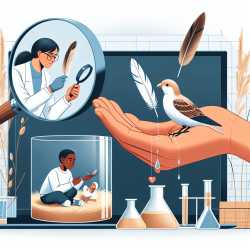Introduction
In the realm of speech-language pathology and therapy, data-driven decisions are paramount. As practitioners dedicated to improving outcomes for children, we often rely on innovative research to guide our practices. A recent study, "Validation of an Alternative Feather Sampling Method to Measure Corticosterone," provides valuable insights that could influence how we approach stress measurement in birds, with potential implications for our field.
The Study's Findings
The research conducted by Voit et al. (2020) explores an alternative method of measuring corticosterone levels in birds by cutting feathers instead of plucking them. The study aimed to validate this less invasive technique, which aligns with the 3-R Principle—replace, reduce, and refine animal use in research.
The study involved geese and ducks, comparing corticosterone levels in feathers collected through cutting and plucking. Results indicated no significant differences between the two methods, suggesting that cutting feathers could be a viable alternative to the more painful plucking method.
Implications for Practitioners
As practitioners focused on creating positive outcomes for children, it's crucial to consider how these findings might translate into our work. While the study directly pertains to avian research, the underlying principles of reducing stress and refining methodologies can be applied to our practice.
- Reducing Stress: Just as cutting feathers is less stressful for birds, we should strive to minimize stress in therapeutic settings. This could involve using more gentle, child-friendly assessment and intervention techniques.
- Innovative Approaches: The study encourages us to explore alternative methods in our practice. Whether it's adopting new technologies or refining existing techniques, innovation is key to improving outcomes.
- Data-Driven Decisions: The research underscores the importance of data in validating new methods. In our field, collecting and analyzing data can help us make informed decisions about the effectiveness of our interventions.
Encouraging Further Research
While the study provides promising results, it also highlights the need for further research. The authors recommend additional studies on different bird species to confirm the findings. Similarly, in speech-language pathology, ongoing research is essential to validate and refine our practices.
By staying informed about the latest research and being open to new ideas, we can continue to enhance our skills and provide the best possible outcomes for the children we serve.
Conclusion
The validation of an alternative feather sampling method for measuring corticosterone offers a less invasive approach that aligns with animal welfare principles. For practitioners in speech-language pathology, this study serves as a reminder of the importance of innovation, data-driven decisions, and the continuous pursuit of knowledge.
To read the original research paper, please follow this link: Validation of an Alternative Feather Sampling Method to Measure Corticosterone.










